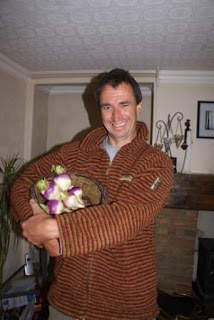It's been a long day, 16 hours 51 minutes 30 seconds to be precise.
An awful lot has happened so the day deserves a blog post all to itself.
Allegedly the first day of summer too, though nobody told the weather gods.
Sunrise was 4.36am today. I didn't get up to see it, though I was up about an hour later. However, it wasn't till the afternoon that the sun finally put in an appearance after a thoroughly damp morning.
Here my strawberries aren't quite ready yet, though I've been offered the chance to pick all that I want from next door this year.
One newspaper article described a June full moon coinciding with summer solstice as a "once in a life time" occurrence. They clearly don't understand statistics. As full moons come round every 28 days, surely you'd be unlucky if there was only one in your life time!
When I checked, the last time this occurred was 22 June 1967 - when I was almost one year of age. If I live to nearly 96 I'll see it again on June 21st 2062.
First Red Duke of Yorks
So with the strawberries stubbornly refusing to ripen I went for the next best thing and dug up my first outdoor grown new potatoes of the year. I could have waited longer and got bigger tubers, but there will be enough and the first potatoes of the year always feel special. I love the deep red colour of Red Duke of York and I love the fact that this early variety is so floury and makes excellent chips. For the classic new potato taste, though, I've grown Dunluce outside this year and Arran Pilot in the polytunnel, the last of which we have just consumed.
Two new lambs
First smallholding business of the day was to drop by in Upwell to pick up a bone saw and a few other bits and pieces. I don't do much butchery but it was going second hand and always handy to have.
Then on to Church Farm Rare Breeds Centre in Stow Bardolph to pick up two lambs. These are just for fattening up - the farm buys in orphan lambs as this is their main attraction and income during the spring. Luckily for me, it means they have a supply of ready weaned, tame sheep all ready to go just as the grass is getting long. They'll join the Shetlands for five months before going off to slaughter, so I won't be giving them names or getting too attached to them.
The turkey poults stayed in this morning. With the weather being cold and damp I thought it best to play safe. One of them jumped the stable wall with mum though and spent the day having some quality one to one time with her. The weather brightened up for the afternoon and the rest of the poults came out. Arthur joined them, He gets on well with the turkey family.
There's a but of a buzz round here
I'd been up for about eight hours and still there was half the day to go. Now another name for the Strawberry Moon is the Honey Moon, which turned out to be a far more appropriate name for today.
After a little early afternoon nap (it was, after all, a very, very long day), I took the dogs out to check on the sheep and turkeys. But something was amiss. There was a buzz in the air. And I mean a BUZZ.
Thousands and thousands of bees were swarming around hive number one. The cloud of bees stretched over toward the veg patch. There must be a swarm somewhere but I just couldn't get close enough to see. I gingerly skirted round, taking a very wide berth, until I eventually came across this.
 |
| Incoming! |
A solstice chick
Remember I said it was a long day. Well there was more. For when I came in from recapturing the bees one of the Ixworth chicks had hatched and several more were pipping. By tomorrow there could be eighteen of them to look after!

And so I sit here watching the first episode of the new Top Gear I've managed to catch up with before I turn over for the start of the England Match. It's now a beautiful evening to be watching the beautiful game.
When the sun sets at 21.28 I'll go and put the chickens away and hopefully get to admire the Strawberry Honey Moon.




































































